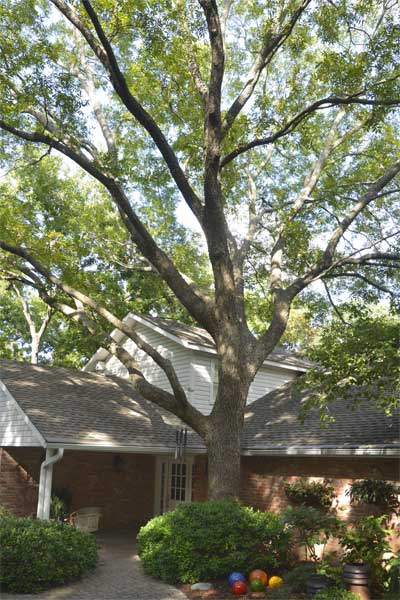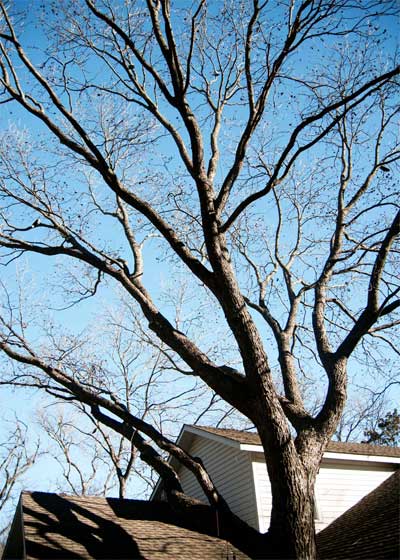From the Sperry Gardens – October, 2012

We bought our little 11-acre rural spot in 1971 with the intent of raising our kids outside of the big city environment. Somehow, we managed to fit our house into a pecan forest without taking down even one native tree. Oh, we lost a bois d’arc and a scrubby redcedar or two, but no pecans, cedar elms or oaks were harmed in the making of this house.
There was a time, for the year or two after we built our house in 1977, that I wasn’t quite sure that I’d be able to say that, however. I was working for the Extension Service, and we were only able to visit our home-to-be on off days and weekends. I was working in West Texas the week that the foundation was framed and poured, and when I returned, much to my horror, I found that the slab was 18 inches closer to this pecan than it was supposed to be. And, compounding the problem, the dozer-guy had taken 8 inches of topsoil away from its entire root system.
I brought the soil back around the tree’s trunk right away. It leafed out normally the next spring, but by the end of August 1978, it was completely bare. I was sure we would lose it. However, it leafed out again in spring 1979, and that year, it held its leaves clear up to first frost. In spite of the heat and drought of the summer of 1980, it began to put on new growth, and I knew our tree was going to be fine.
Now, the pecan that was only 8 inches in diameter is more than 27 inches through, and it provides shade to all of our courtyard and probably 75 percent of our house. It is, by far, the largest tree on our property. It probably has benefited from all the moisture that has spilled down our driveway, and I’m sure it has roots deep beneath our foundation. However, the architect designed the slab to have extra piers and stronger beams, and I removed a threatening root early-on, so we’ve had no problem to-date. No, that’s not quite right. I did have to have the guttering taken down and cut into two pieces. The trunk was beginning to rub into it. Eventually, we (or our heirs) will have to notch into the soffit, but I’ll save that worry for another day.

The more immediate concern that I had was from one of the lowest limbs on this tree. If you look closely, it’s the one supporting the wind chimes. It arched out and over our roof, our drive and a big part of my landscape. My friend, TAMU pecan specialist Dr. George Ray McEarchern once told me that "When two pecan branches touch, one will die," and I’ve observed that happening in all of my trees ever since. This big branch was starting to show signs of such dieback, so I asked the men at Arborilogical Services to take it down before it weakened and fell.

Three things are worthy of note here. First, this pruning was done in early fall. We often think that winter is the only time you can trim large shade trees. While winter may be the very best time to trim oaks specifically, good arborists do their work year ’round.
Also, you’ll see that the limb wasn’t removed flush with the remaining limb. Instead, an inch or so of branch collar was left in place, so that the wound wouldn’t be so large, and so that the roll of new bark would more quickly be able to form across the cut surface.
Finally, note that there is no pruning sealant on this cut surface. Arborilogical Services has done all of my tree work for the past 20 years, and they have never used one ounce of sealant. Research has shown that it actually slows the healing process across cuts like this. The only time it’s recommended is with oaks, and that’s just to protect them from the invasion of oak wilt.
Our children and our grandchildren have ridden tricycles and played basketball beneath this great old tree. Hopefully it will hang around for several more generations.

